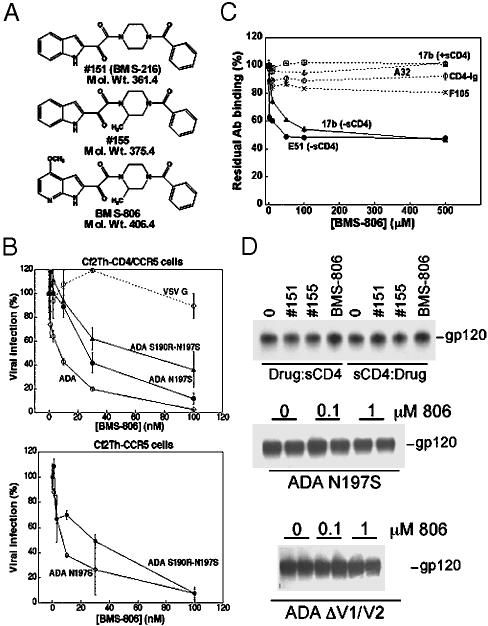Fig. 1.
BMS-806 does not inhibit HIV-1 receptor binding. (A) The structures of BMS-806 and related compounds #151 and #155 are illustrated. (B) Recombinant HIV-1 viruses expressing firefly luciferase and containing the indicated envelope glycoproteins were used to infect Cf2Th-CD4/CCR5 or Cf2Th-CCR5 cells in the presence of different concentrations of BMS-806. The percentage of luciferase measured in the target cells relative to that observed in the absence of drug is shown. The values shown represent the means and SDs of triplicate points in the assay. The results are typical of those obtained in three independent experiments. In separate experiments, BMS-806 did not inhibit the infection of Cf2Th-CCR5 cells by HIV-1 viruses pseudotyped by vesicular stomatitis virus glycoproteins (data not shown). (C) The YU2 gp120 glycoprotein was captured on ELISA plates coated with the D7324 antibody. Antibodies or CD4-Ig were incubated with the captured gp120 in the presence of the indicated concentrations of BMS-806, and, after washing, bound ligand was detected by peroxidase-conjugated goat anti-human IgG (Ig-constant region-specific) antibody. The values shown represent the optical densities obtained, relative to those observed for each ligand in the absence of BMS-806. (D)(Top) Radiolabeled ADA gp120 was incubated either first with BMS-806 followed by sCD4 or first with sCD4 followed by BMS-806. The mixtures were then incubated with Cf2Th-CCR5 cells; the bound gp120 glycoproteins are shown. (Middle and Bottom). Radiolabeled ADA N197S gp120 or ΔV1/V2 gp120 glycoproteins were incubated with Cf2Th-CCR5 cells without the addition of sCD4 and in the presence of the indicated concentrations of BMS-806. The bound gp120 variants from duplicate experiments are shown.

